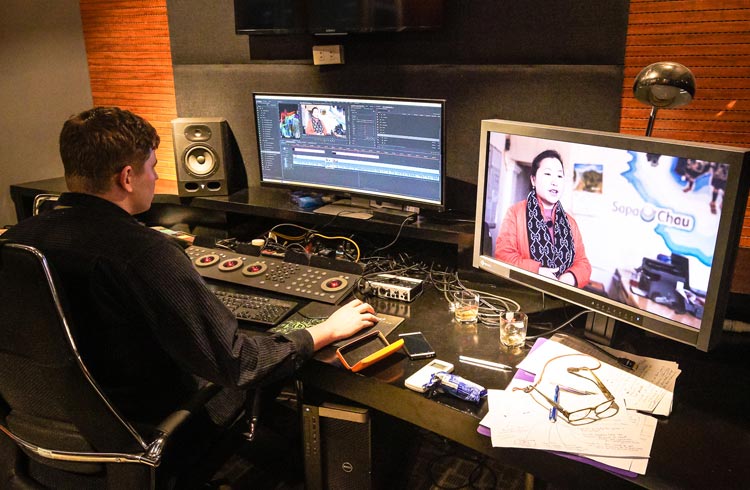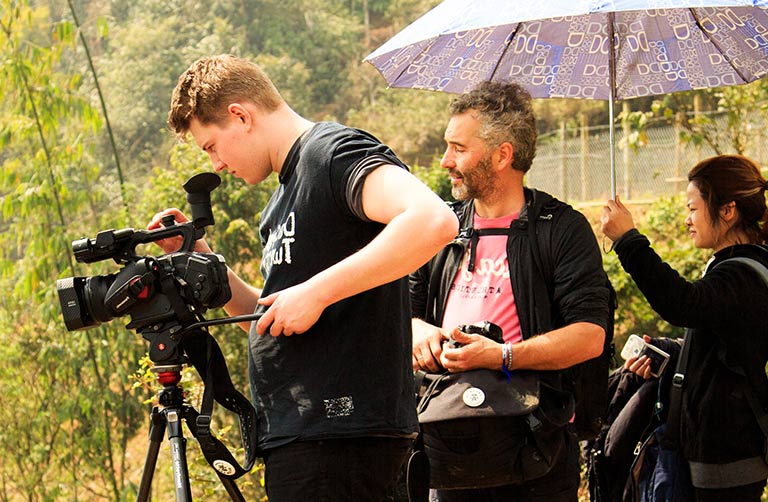Award-winning documentary maker (and World Nomads Film Scholarship mentor), Brian Rapsey explains how the right hardware and software ensure a smooth editing process.
 Photo © Brian Rapsey
Photo © Brian Rapsey
I started editing in the early ‘90s, cutting tape on a 16mm Steenbeck flatbed film editing table (a machine used to edit film). Since then, I’ve been through all the major editing systems. My first travel 'micro-doc' job was flying around Australia making stories about the remote places that the Olympic torch relay passed through – all edited in the field on the first-ever version of Final Cut Pro.
Now is the best time to be a video editor in terms of accessibility: the free and affordable editing platforms now available online can do things I could only dream of when I started. The drawback is that editors used to require more assistants, which was a great way to break into the industry. Those days are over, but aspiring filmmakers can now look to YouTube tutorials in order to learn their craft.
The hardware
The first thing to remember is that video editing is a power-hungry enterprise. I have a Mac desktop and an old light 13-inch MacBook Pro for storing and reviewing material when on assignment.
When you think about editing you need to consider the following: the Central Processing Unit (CPU) processor power (basically the speed the computer processes tasks); Random Access Memory (RAM, the amount of memory storage the computer has); the Graphics Processing Unit (GPU, the size of this determines how quickly images and video can be processed); your hard drive storage size (where your videos and photographs will be stored); and, crucially, the speed between your hard drive and your computer. The best drive is an SSD hard drive (a Solid State Drive – where your footage is stored on computer chips rather than on spinning discs). SSD Drives are fast, small and expensive; Standard 'spinning' hard drives will store much more data for your dollar and are more than adequate – as long as their connection speed to your computer is fast enough. An older USB2 port is too slow, a USB3 port is fast enough, while a USB C port is super fast and now standard on new computers. If you're buying a second-hand computer, the speed of its built-in USB connections is important, so make sure to check that before you buy. Let’s look in more depth at some of the hardware.
Central processing unit
The central processing unit (CPU) performs the basic processing tasks of the computer – the faster and more CPU ‘cores’ your machine has (as computers can run multiple CPUs at the same time), the faster and more responsively your computer will perform tasks. All editing software has a list of minimum hardware requirements, so check out the software links later in this article to find out what you need.
Random access memory
While the information that is stored on your hard drive stays there, random access memory (RAM) disappears when you turn your computer off. The more RAM you have, the easier you will find editing, as video editing software uses a lot of it. My laptop (featuring 8 gigabytes of RAM) can barely keep up with my editing needs and most modern editing software recommends a minimum of 16 gigs of RAM. The trouble with my laptop is that I can’t add more RAM – so it’s nearly obsolete when it comes to modern editing software requirements. My advice: make sure the computer or laptop you buy is capable of RAM upgrades in the future.
Graphics processing unit
Since the advent of 64-bit processing, computer processors have been able to access the processing power and the RAM available on their graphics cards, which is the part of the computer dedicated to displaying graphics and images on your screen. This has been the real revolution in editing software performance in recent times.
Before you buy a computer, find out what GPU it has and read the reviews. A good GPU will have at least 6GB of available memory. You can also add more GPU power by connecting an external GPU via a USB C high-speed transfer port. One excellent external GPU is the Blackmagic e-gpu.
Hard drive storage
The major downfall of older computers is the transfer speed of their USB ports: you don’t want a computer that only supports a USB2 transfer speed, as it won’t be fast enough. You need adequate bandwidth (data transfer speed) to transfer high-resolution video from your hard drive to your computer. If you shoot a lot of video, you will fill up the internal hard drive of your computer quickly. I recommend that you have at least two external hard drives: one to play back your video footage, and another as a safety backup. When I’m traveling on assignments, I always hide the backup hard drive under the mattress.
My advice is to buy the best computer you can afford. If you are buying second-hand, you can get more bang for your buck, but make sure you do your research. You need to understand CPU, GPU, RAM and storage and how they affect your ability to edit. It's also important to check if you can upgrade your RAM and GPU in the future.
If you can only afford a slower computer, fear not, as there is a hack: many video editing programs allow you to create and edit your story from proxy media. Proxy media is a low-resolution copy of the original footage that is easy for a less powerful computer to playback, edit and process effects. Editing with proxies takes the burden off your computer when you are editing. When you make the final master of your video, the computer will generate this from your original high-resolution media. Many editing software platforms make this process incredibly easy – and I use it all the time even on my powerful machine as it will playback even the most effect-heavy edits in real-time.
The software
The good news is that you can start editing on free or inexpensive software and then upgrade later. If you are using Apple, you can start with iMovie for free. You can work on a portable device or computer and learn the basics and do most of your editing work – and it is super easy and intuitive.
If you want to get more professional you can import and upgrade your iMovie project into Apple’s more professional editing platform, Final Cut Pro X. You will need to pay upfront for a permanent license, which starts at around $300.
Another option is to use Adobe’s Rush system, which works on any device. If you decide to upgrade to Premiere Pro in the future, you can easily transfer your files from Rush. Rush starts at US$9.99 a month for students and US$19.99 a month for everyone else.
Premiere Pro is probably the most widely used video editing software. Like with all Adobe products you need to pay a monthly subscription fee (starting at US$50 for Premiere Pro), but students can access Adobe’s Creative Cloud services for US$19 in the first year. All of our scholarship winners have used this software to edit their entries.
Another option is Davinci Resolve, which is one of the most sophisticated editing platforms on the market. Originally, it was created as a high-end color grading software (the film Avatar was graded on Resolve), but it’s now a fully featured editing and sound-mixing platform. There are two versions, Free and Studio; beginners should opt for the Free version, as it’s only missing just a few features. The Studio version costs US$300 and has all the bells and whistles. While some aspects of the program can be intimidating for beginners, it’s relatively easy to learn and the basic interface is the same as any other editing software.
Related articles
Simple and flexible travel insurance
You can buy at home or while traveling, and claim online from anywhere in the world. With 150+ adventure activities covered and 24/7 emergency assistance.
Get a quote


No Comments